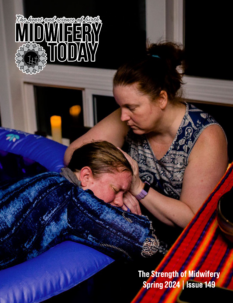
Routine Active Management of the Third Stage
Editor’s note: This article first appeared in Midwifery Today, Issue 109, Spring 2014.
Subscribe to Midwifery Today Magazine
The International Confederation of Midwives (ICM) and the Federation of Gynecologists and Obstetricians (FIGO), along with many others, have signed on to the idea that women can no longer birth their placentas naturally, and therefore sent out the message that all women should be “offered active management of third stage.” Unfortunately, this “offer” usually turns into a fear-based acceptance because women are often told, “You will die if we don’t do this.” Active management has become routine in many places, with practitioners doing it without any explanation, thereby giving the message that “patients” just aren’t smart enough to make their own decisions. I wrote an editorial on this active management protocol decree when it first came out in 2003 (midwiferytoday.com/mt-articles/icm-and-hemorrhage/).
Messing with God’s design and Mother Nature is almost always dangerous. The case of active management of the third stage is no exception. It is always best to consider if a birth practice causes hemorrhage. Are you messing with the natural oxytocin flow of the mom by disturbing her after birth as you mess with her fundus? This can cause a hemorrhage. Is baby skin-to-skin? Hopefully so, because this reduces her chance of hemorrhage. Have you pulled on the placenta? Hopefully not, because this can cause a bleed.
The active management of the third stage decree was done to save the lives of mothers. This is obviously important, but individual circumstances were not considered and so the practice became the norm. A practice that makes sense in a country where medical equipment isn’t readily available in the case of an emergency doesn’t necessarily make sense in a population of well-nourished moms. Other options should be considered before resorting to active management, such as herbal remedies, placentophagy or using the cord and membranes to stop a bleed (putting either inside mom’s cheek). See my full editorial, “Lessons from Kitty Birth: Using Placenta to Control Hemorrhage”.
In the editorial mentioned above, I said of Kitty, “As she ate the placentas, I realized that I have never heard of a cat, goat or dog hemorrhaging to death or even suffering too much blood loss. Humans have been so foolish in not following God’s plan, and we have probably sacrificed millions of women to hemorrhage when the cure was and still is right there within her body.” For my kitty birth editorial, I had asked midwives how effective the placenta was for hemorrhage control. Everyone who answered said it stopped the hemorrhage immediately. Generally only a small quarter-size piece of placenta was placed in the mom’s cheek (buccal placenta). I came to consider that if we use the placenta, membranes and cord as anti-hemorrhage agents, this would make active management of the third stage of labor obsolete. Placenta is a natural part of the birth process, and using it reduces the chance of exposing motherbaby to the dangers of drugs like Cytotec and Pitocin.
Hemorrhage is often caused by hurrying the placenta. There is a mistaken theory that placentas have to come out within a few minutes of birth; many practitioners hurry third stage, thereby causing the hemorrhage we are trying so hard to prevent. This practice has spread like wildfire. Women and their babies deserve better. They deserve to be treated with respect—they are our next generation. The after effects of birth last a lifetime.
One of Midwifery Today’s former editors has a goat herd. Occasionally, one of her goats won’t birth the placenta until the day following the birth of the baby goat. If women are supposed to have their placentas so quickly after birth, I wondered how goats could safely birth a placenta a whole day later since they are mammals like us. I asked Michel Odent, who is my go-to person for questions like these. He said practioners worry about the cervix closing down and want to birth the placenta quickly because synthetic oxytocin can cause such a problem to occur. In a natural birth then, this is not as much of a worry.
The important issue for us as midwives is to be able to individualize care. If a multip has suffered postpartum hemorrhage in the past, then maybe active management could help. Or perhaps you and the mom decide that trying a piece of placenta or cord might work. Women are smart and can help solve issues in their births prenatally with their midwives and doctors. Blessed are the few women who get truly individualized care.

 Jan Tritten is the founder, editor, and mother of Midwifery Today magazine and conferences. Her love for and study of midwifery sprang from the beautiful homebirth of her second daughter—after a disappointing, medicalized first birth in the hospital. After giving birth at home, she kept studying birth books because, “she thought there was something more here.” She became a homebirth midwife in 1977 and continued helping moms who wanted a better birth experience. Jan started Midwifery Today in 1986 to spread the good word about midwifery care, using her experience to guide editorial and conferences. Her mission is to make loving midwifery care the norm for birthing women and their babies in the United States and around the world. Meet Jan at our
Jan Tritten is the founder, editor, and mother of Midwifery Today magazine and conferences. Her love for and study of midwifery sprang from the beautiful homebirth of her second daughter—after a disappointing, medicalized first birth in the hospital. After giving birth at home, she kept studying birth books because, “she thought there was something more here.” She became a homebirth midwife in 1977 and continued helping moms who wanted a better birth experience. Jan started Midwifery Today in 1986 to spread the good word about midwifery care, using her experience to guide editorial and conferences. Her mission is to make loving midwifery care the norm for birthing women and their babies in the United States and around the world. Meet Jan at our 
















